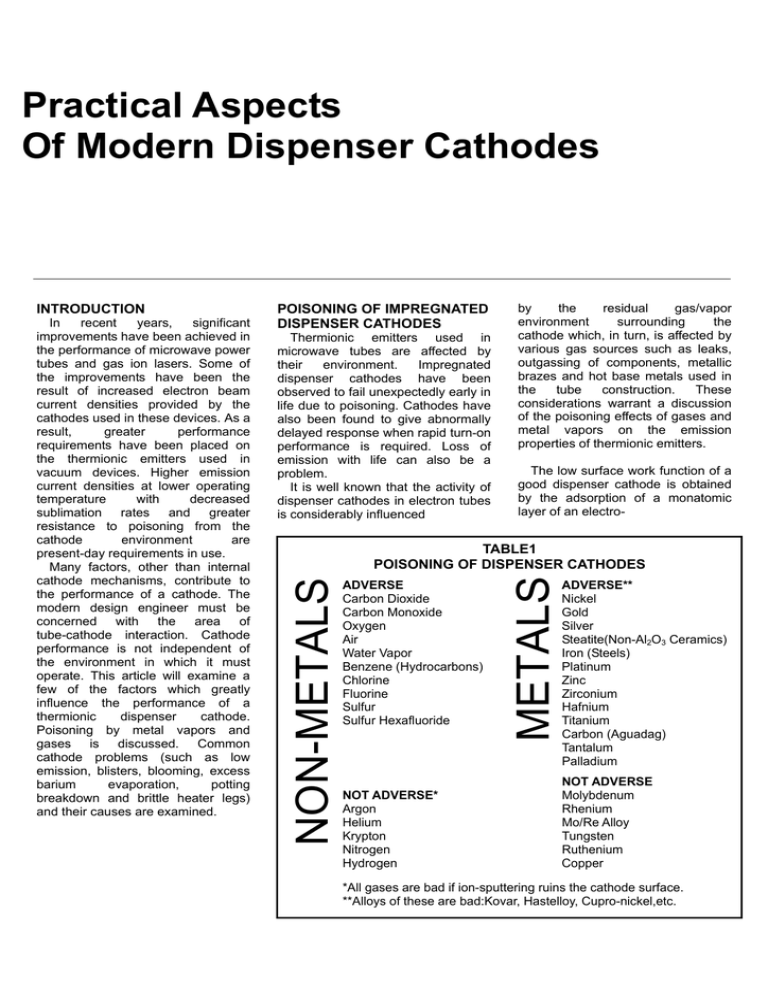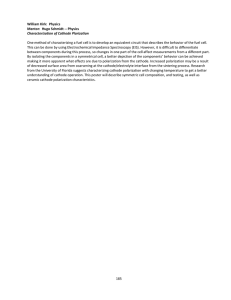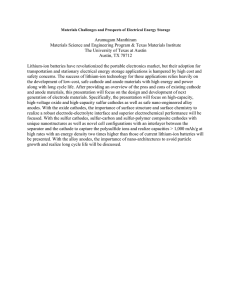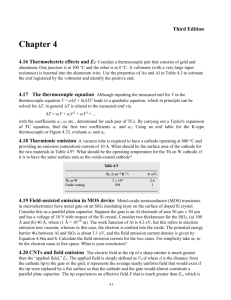Practical Aspects Of Modern Dispenser Cathodes
advertisement

Practical Aspects Of Modern Dispenser Cathodes POISONING OF IMPREGNATED DISPENSER CATHODES Thermionic emitters used in microwave tubes are affected by their environment. Impregnated dispenser cathodes have been observed to fail unexpectedly early in life due to poisoning. Cathodes have also been found to give abnormally delayed response when rapid turn-on performance is required. Loss of emission with life can also be a problem. It is well known that the activity of dispenser cathodes in electron tubes is considerably influenced by the residual gas/vapor environment surrounding the cathode which, in turn, is affected by various gas sources such as leaks, outgassing of components, metallic brazes and hot base metals used in the tube construction. These considerations warrant a discussion of the poisoning effects of gases and metal vapors on the emission properties of thermionic emitters. The low surface work function of a good dispenser cathode is obtained by the adsorption of a monatomic layer of an electro- TABLE1 POISONING OF DISPENSER CATHODES ADVERSE Carbon Dioxide Carbon Monoxide Oxygen Air Water Vapor Benzene (Hydrocarbons) Chlorine Fluorine Sulfur Sulfur Hexafluoride NOT ADVERSE* Argon Helium Krypton Nitrogen Hydrogen METALS In recent years, significant improvements have been achieved in the performance of microwave power tubes and gas ion lasers. Some of the improvements have been the result of increased electron beam current densities provided by the cathodes used in these devices. As a result, greater performance requirements have been placed on the thermionic emitters used in vacuum devices. Higher emission current densities at lower operating temperature with decreased sublimation rates and greater resistance to poisoning from the cathode environment are present-day requirements in use. Many factors, other than internal cathode mechanisms, contribute to the performance of a cathode. The modern design engineer must be concerned with the area of tube-cathode interaction. Cathode performance is not independent of the environment in which it must operate. This article will examine a few of the factors which greatly influence the performance of a thermionic dispenser cathode. Poisoning by metal vapors and gases is discussed. Common cathode problems (such as low emission, blisters, blooming, excess barium evaporation, potting breakdown and brittle heater legs) and their causes are examined. NON-METALS INTRODUCTION ADVERSE** Nickel Gold Silver Steatite(Non-Al2O3 Ceramics) Iron (Steels) Platinum Zinc Zirconium Hafnium Titanium Carbon (Aguadag) Tantalum Palladium NOT ADVERSE Molybdenum Rhenium Mo/Re Alloy Tungsten Ruthenium Copper *All gases are bad if ion-sputtering ruins the cathode surface. **Alloys of these are bad:Kovar, Hastelloy, Cupro-nickel,etc. positive material onto a suitable substrate. It is evident that the dipole effect of this monolayer, which lowers the work function, will be modified by the adsorption of gas or metal vapor onto its surface, particularly if the gas or metal is electro-negative. In this case, the work function will increase and cause a decrease in emission, usually termed emission poisoning. Table 1 tabulates gases and metals commonly found in microwave tubes. It is apparent that very few materials or gases are relatively safe to put in the environment surrounding the cathodes. Some, like tantalum, are particularly bad because they getter when hot and then release the gettered gases when cooled. Figures 1 and 2 show the effects of common gases on Fig. 1 Poisoning of impregnated cathodes by gas. Emission current. (Reference: Jenkins and Trodden, J. Electron. Contr., 10., 1961) The graphs show the cathode current normalized to the unpoisoned starting cathode current versus tube pressure. Oxygen, water vapor, carbon dioxide and air all poison impregnated cathodes. There is a critical pressure for each of these gases below which no poisoning occurs and this critical pressure increases with cathode tempera- Fig. 2 Poisoning of impregnated cathodes by gas. ture. Poisoning increases very rapidly when the pressure is increased above the critical value. Complete cathode re-activation after poisoning is generally possible, the rate increasing with cathode temperature. The main practical conclusions are that for the average barium-calcium-aluminate cathode operating at 1100°C, partial pressures of 10-7 torr of oxygen, 3× 10-7 torr of water vapor, 10-6 torr of CO2 and 5×10-6 torr of air should never be exceeded for freedom from poisoning. The gases which are harmless to the emission include nitrogen, hydrogen and the rare gases, apart from any high voltage sputtering effects which may be present. Hydrocarbon vapors tend to leave carbon in the cathode, which will improve its activity at the expense of a deterioration in the vacuum due to the production of carbon monoxide. Finally, if the ambient partial pressure of poisoning gases is near the critical limit, relatively small variations in the rate of production of barium from the cathode will cause large variations in the emission achieved for a given temperature. Figures 3 shows the effects of common metals on emission current (Reference: Vaughn, Dudley and Lesensky, Conf. On Tube Tech., 1960, p. 140) The graphs show the cathode current normalized to the unpoisoned starting current versus the metal temperature and vapor pressure. Cathode test temperature is 1100°C. The mechanism of cathode poisoning due to metal vapors is not well understood. The story of what happens when an emitting surface is subjected to bombardment by hot metallic particles may involve the binding of some barium atoms to the metal particles, the alloying of the condensed metal with the tungsten matrix and other phenomena. Whatever the activity at the cathode, the action of the metal particles on the cathode emission seems to be a function of the rate of arrival of these particles at the cathode and the number of these particles that arrive per second. Fig. 3 Poisoning of dispenser cathodes by metal vapors. Practical conclusions are that all metal vapors shown in Figures 3 poisoned the cathode except copper. Lower melting point metals poison the cathode at lower poisoning agent temperatures. Silver poisons at the lowest temperature, with gold, nickel, titanium, iron, platinum and zirconium following in that particular order. The safest material to use for cathode support structures and heat shields is the 50/50 alloy of molybdenum and rhenium. This material does not getter gases, has poor thermal conductivity, and spot welds readily. COMMON CATHODE PROBLEMS Table II presents a listing of the most common problems encountered by the cathode user. The problems are not peculiar to the microwave electron tube industry but can be found in the CRT industry, ion gas laser industry and the aerospace industry. TABLE II COMMON CATHODE PROBLEMS LOW EMISSION BRITLE HEATER LEGS BLISTERS BLOOMING POTTING BREAKDOWN EXCESS BARIUM EVAPORATION Low Emission The most common cause for low emission current is poisoning. The cathode may be poisoned in some subtle ways: water, saliva and glass dust from opening the glass cathode shipping vial; plating from helices; spot weld splash; sulfur from pole piece steel; poor exhaust procedures. The emission may also be reduced due to the loss of emitting area by lost tips (low noise types), chips, alloy formation, grids and ion-bombard-ment spots. Emission current may drop due to decreases in operating temperatures. Temperature changes can be caused by: electron cooling during CW emission; increase in thermal emissivity; increase in thermal conductivity from shields; supports; deposits; emissivity changes, etc. Other apparent causes for low emission are; inadequate design margin between space-charge operation and temperature-limited operation; normal barium depletion during life; virtual leaks in the vacuum envelope; and heater shorts or partial shorts. Brittle Heater Legs Heater legs may be made brittle in several ways. First, firing a cathode while supporting the heater legs with set screws made of steel will embrittle the tungsten-rhenium heater wire. Any material containing sulfur, iron, oxygen, chromium or nickel must not be in contact with a hot heater wire. A second cause of embrittlement is firing the cathode in a bell jar where the vacuum is 10-6 torr or higher. Residual oxygen causes the hot heater leg to become brittle. Blisters Blisters may occasionally occur on the surface of the cathode due to too rapid heating after inadvertent exposure to moisture.during assembly and handling. The vapor pressure of water at 375°C is 3,200 lb/in2 which indicates the tremendous pressure which can be generated within the tungsten matrix by absorbed moisture. Blisters can be avoided by a slower rate of heating. The mechanism by which blisters are formed is not very well understood, but it is well known that protecting against moisture pick-up and slow heating schedules will minimize the possibility of blistering. Blooming The impregnated cathode must be protected from long periods of atmospheric exposure. Barium calcium aluminate is very hygroscopic. It will readily absorb moisture, converting the oxides to carbonates and which results in a volume expansion and an exuding of the impregnant from the pores of the tungsten emitter. This blooming can be easily brushed off the cathode surface. The only negative effect caused by blooming will be an initial gas burst larger than normal during the first cathode heating. It should be pointed out that a great deal of handling in air is permissible during the mounting of the cathode in a tube. Some cathodes have remained exposed to air for months, with no noticeable effect on subsequent performance in tube. Cathodes and cathode assemblies should be stored in a vacuum (10-3 torr or better), dry box, or inert gas atmosphere (argon, nitrogen) until ready for use. Potting Breakdown The breakdown of the insulation between the heater and cathode can occur due to a gradual phys- ico-chemical process. When the heater is positive with respect to the cathode, negative oxygen ions are drawn to the heater where they cause oxidation. The tungsten oxide thus formed dissolves in the alumina, producing an aluminium tungstate. The resistance of this compound is much lower than that of alumina. After a time, leakage current develops and finally, catastrophic failure. The situation is less serious if the heater is negative with respect to the cathode. Obviously, this condition is very serious if the heater is powered by direct current. If dc is used, the heater should always be negative with respect to the cathode. Excess Barium Evaporation The sublimation products of the dispenser cathode have plagued tube engineers for many years. The evaporants can cause frequency shifts in magnetrons, grid emission in linear beam tubes and ceramic insulation failure in all microwave tubes. The evaporation rate is a function of the cathode operating temperature only. The tube engineer must choose the operating temperature so that adequate space charge current is obtained at the minimum evaporation rate. For any given evaporation rate, the emission for the three common impregnants is virtually the same as shown in Figures 4. The evaporation rate at a fixed temperature is a sensitive function of the BaO content shown in Figure 5a. Figure 5b shows the effect of the tungsten matrix porosity on evaporation rate. Unfortunately, porosities of 16% or less do not impregnate reliably. Jim L. Cronin is the Vice-President for Research and Development at Spectra-Mat, Incorporated, Watsonville, California. He is responsible for the development of high performance thermionic dispenser cathodes and ion sources. Jim received his BS in Electrical Engineering from Santa Clara University. Prior to joining Spectra-Mat in 1977, he worked in the microwave tube industry as a project engineer in the low power, low noise traveling-wave tube area and as a production/development engineer in the high power-traveling wave tube area. As reprinted from MICROWAVE JOURNAL, September 1979.






